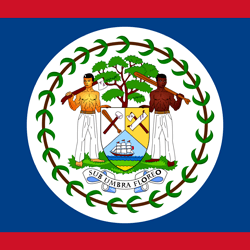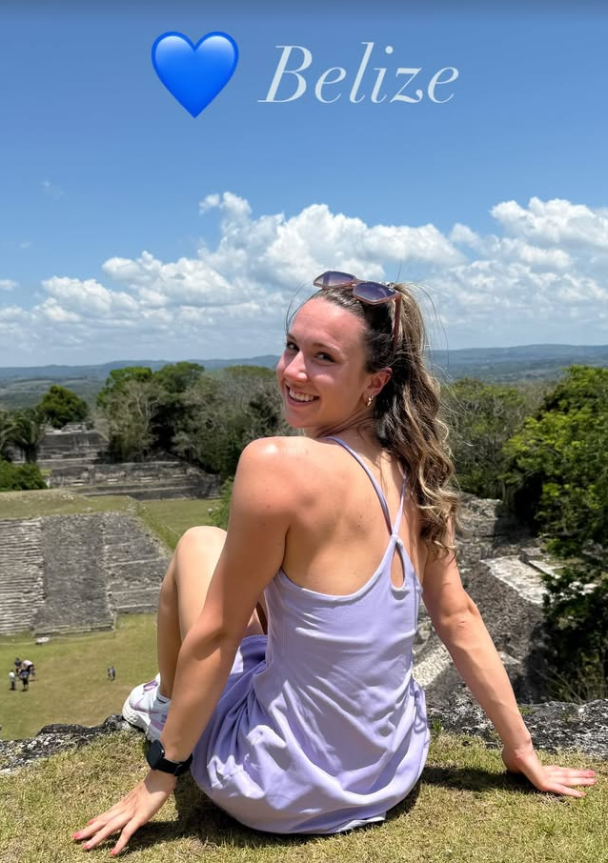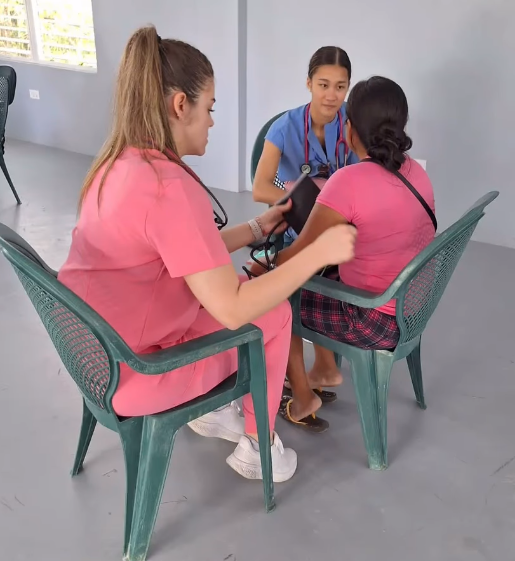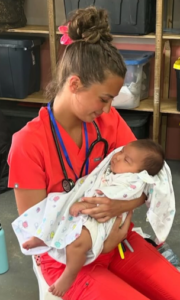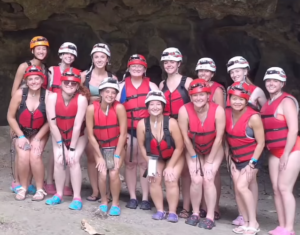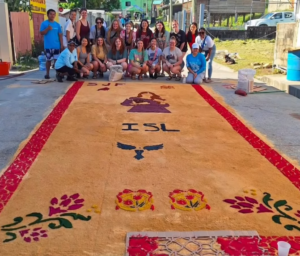About Belize
Known as the Jewel of the Caribbean, Belize is a land of ancient treasures, teeming with life and mystery. Here, shaded below jungle canopies, you can find ancient vine-wrapped temples of the Mayan Empire. Beneath its ocean waves you can discover the largest barrier reef in the Western Hemisphere. Underground, there are caves and waterways that often appear on the surface as small blue pools. But the greatest treasure of Belize can be found beneath sheet metal rooftops of informal settlements and cloth awnings of remote jungle villages–its people. When you volunteer in Belize with ISL, you’ll discover more than just what’s on the surface. You’ll see more than sparkling beaches and colorful wildlife. You’ll do more than zipline through jungle treetops or crest Mayan ruins. You’ll have the opportunity to serve others, and in doing that, you will find the true Jewel of the Caribbean.
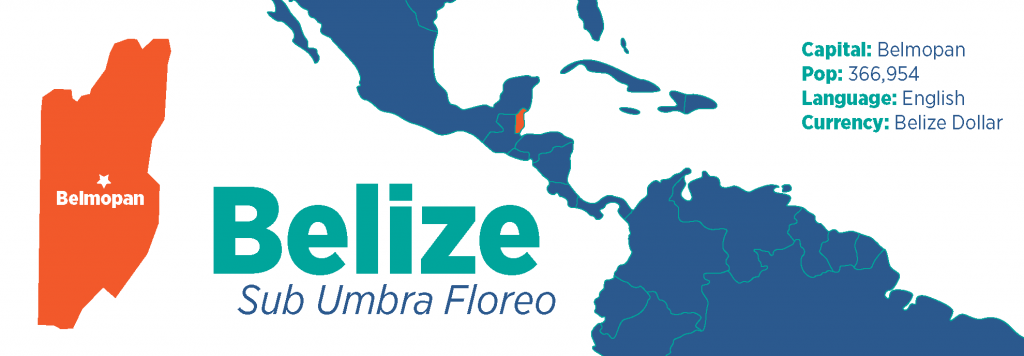
A Brief Overview of Belize
Belize is considered a jewel in Central America. It is well known for its rich Mayan heritage, and evidence of this is visible with its numerous archaeological sites referred to by locals as “Maya ruins.” Home to the world’s second longest barrier reef, Belize is an ideal spot for deep sea fishing, diving, snorkeling and numerous other water sports, and is one of the world’s leading tourist destinations. As for native Belizeans, tourism and agriculture are their main sources of income, and it’s easy to see why. With an area of 8,867 sq miles, Belize is one of the most sparsely inhabited countries in the world, with only approximately 500,000 residents.
Belize is a Central American country, but it is also considered part of the Caribbean, due to the fact that its entire coastline is washed by the Caribbean Sea. Its history is as unique as its location, having been ruled by England up until September 1981, when it became an independent country. Belize is the only country in Central America with English as its official language, but Spanish is also widely spoken here, due to neighboring Mexico to the north and Guatemala to the west and south.
Where We Serve in Belize
With a low population density and a unique jungle topography, Belize is primarily a rural country with few significantly populated villages and cities. Because of this, the places we serve fall into two categories: rural and semi-rural.
Rural
In the western part of Belize, in the villages of the Cayo District, there is a large population of immigrant families, some of whom settled illegally due to the abundance of rich agricultural land and lack of surveillance by the authorities. Here there is often inadequate infrastructure, basic utilities, and in some cases unreliable transportation. In the southern part of Belize, in the Stann Creek and Toledo Districts, there is a mix of immigrants and native Belizeans who work in the citrus and banana industries. Because this is mostly seasonal work, some people are unable to afford adequate housing and proper healthcare. There is also a large number of indigenous Maya communities in the Toledo District who still believe in living off the land. These communities are deep in the forest and the terrain to access health care comprises of miles of unkept roads and numerous water ways which are easily flooded during rainy season.
Semi-Rural
In the northern districts most villages were settled by sugar cane farmers and fishermen. Many have diversified over the years. Some of these families are better off than many who live in other parts of the country, but inadequate infrastructure and a shortage of basic affordable healthcare is the same as in other villages in Belize.
The Need in Belize
The Belize Ministry of Health and Wellness provides free primary healthcare at community hospitals located in major towns and more advanced care at regional hospitals. Regional care is more expensive, as more advanced tests are often required and regional hospitals can be as far as two hours away from some of the villages in Belize. There is only one tertiary care institution in the country, where patients are referred on a per need basis. The public health department brings mobile clinics to several villages every six weeks, but they provide only post-natal care and administer vaccines.
A large portion of the population in these villages suffer from seasonal illnesses and either use local remedies or receive no treatment at all. Many other villagers suffer from chronic diseases that remain untreated due to the geographical and socioeconomic challenges of obtaining proper medical care. The Ministry of Health and Wellness has Community Health Workers in most communities. These are the feet on the ground and the link between the community and the Ministry of Health and Wellness. They provide health education and conduct home visits, but depending on the size of the community and time of year, it may be difficult for them to reach those most in need. Because this is voluntary work, it takes a special individual to be able to comply with the requirements for a monthly stipend. Lack of adequate health education seems to be a major issue in relation to compliance especially when dealing with chronic diseases.
Our Partnerships
As with any great work, it takes great relationships to get the job done well. That’s why ISL Belize is excited to partner with nonprofits, NGOs, and governmental and religious institutions to better serve the people of Belize.
Nursing Homes
The Octavia Waight Centre in San Ignacio Town
Help Age Belmopan
Schools/ Universities
Primary schools in rural communities
Health Care Agencies
Norther Regional Hospital
Community Health Workers
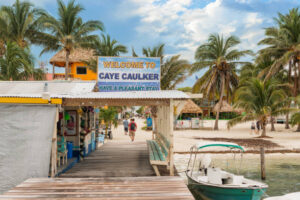
Caye Caulker: Welcome sign at the wooden pier dock in Caye Caulker. It is a small island near Ambergris Caye, Belize.
What to Expect as a Volunteer
With your service program, you’ll arrive in Belize via the Philip S W Goldson International Airport. This is the only international airport in Belize, located approximately 20 minutes away from Belize City. After going through Customs and retrieving your luggage, you will be met by an ISL staff member and transported by, van, or bus (arranged and paid for by ISL) to your hotel or guest house in the area closest to your work site. Depending on the area in which you’ll be volunteering, the ride to housing varies from one to two hours.
You will travel daily with ISL staff to your volunteer location. These villages may be as close as 15 minutes away or as far as an hour away, depending on the time of year and road conditions. You will remain at your assigned housing for the working part of your stay and then relocate to a hotel on the island of Caye Caulker for recreation day activities and your departure the following day.
Cultural Exploration
With ISL Belize, you’ll have many opportunities to explore the culture of those you serve. Here are some of the many possibilities.
Cooking Classes
Learn how to make one of the many famous and delicious Belizean dishes and drinks.
Dance Classes
Learn a variety of local cultural dances including punta, zapatiada, soca and the bruk down.
Tours
Visit numerous archaeological sites, natural medicine trails, the Green Iguana Conservation Project, chocolate making class, caves and waterfalls, and an all time favorite visit to the island of Caye Caulker with an option to snorkel along the Barrier Reef with a stop at the famous Shark and Ray Alley.
Local Farmers’ Market
Although the market is open every day, Tuesdays, Fridays and Saturdays are considered the best market days, when the farmers from neighboring communities offer their best deals on their freshest produce.
Handicrafts
Taught by members of a local women’s group, you can learn how to make native crafts and have something special to take home when you’re done volunteering.
Natural Remedies
Visit with a native Belizean who makes medicines from plants collected in the jungle. Get a close-up view of the process from beginning to end.
Recreation
When it comes time to get out and explore, you’ll see why Belize is said to be one of the most breathtaking places on earth.
Xunantunich
Walk through the ancient ruins of the Mayan Empire and learn about the haunting legend of the Stone Woman.
Cost: $10-$15 dollars (lunch not included), 2-3 hour tour
Lamanai
Take a guided tropical river adventure up the New River and explore Mayan ruins first hand.
Cost: $60-$70 (lunch included) Full Day Tour
Cave’s Branch Outpost
Open for volunteers in the Cayo and Stann Creek District, Cave’s Branch Adventure Company offers the surreal experience of tubing through a jungle cave and the exhilarating rush of a jungle zipline.
Cost: $25-$40 (several options)
Belize’s Barrier Reef
Take advantage of this opportunity to see the beauty beneath the waves of the longest barrier reef in the Western Hemisphere.
Half day snorkeling: Cost: $50. Tropical fruits, water, guide and equipment included.
Full day snorkeling: Cost: $100. Tropical fruits, lunch, water, guide and equipment included.
The Inland Blue Hole
A blue hole is a large marine cavern, or sinkhole, which is open on the surface and perfect for swimming! Dive deep into the enchanting turquoise waters of one of Belize’s best kept secrets.
Cost: $25
Lodging
Whether lodging at a hacienda on the beach of the Sea of Cortez in Puerto Penasco, Mexico; a walled convent in the heart of Alajuela, Costa Rica; or an apartment situated above the bustling metropolis of Santo Domingo, Dominican Republic, ISL’s volunteer lodgings are unique and carefully chosen based on very important criteria.
Accommodations are safe, clean, and within reasonable driving distance to service sites and recreational opportunities. Volunteers are provided their own bed, easy access to restrooms and showers, and meeting spaces for training and fellowship. Many ISL accommodations are unique and may include retreat houses, guest houses or home stays, all of which provide a distinctive cultural experience. ISL Country Coordinators will provide a description of your lodging in the Final Trip Document posted to your My ISL portal prior to your departure.
Hilltop Horizon Guest House
San Ignacio Town, ph: +501-601-1099; This is a family-run establishment that operates to accommodate ISL volunteers in the area (2 hours away from the airport).
Las Palmas Hotel
#123 5th Avenue, Corozal Town, Belize; Phone: 011-501-422-0196; www.laspalmasbelize.com (2 hours away from the airport).
D Victoria Hotel
#40 Belize Corozal Road, Orange Walk Town, Belize; Phone +501-322-2518; dvictoriabelize.com; social media www.facebook.com/dvictoriahotel (1 hour away from the airport).
Hotel dela Fuente
#14 Main Street, Orange Walk Town, Belize; Phone +501-322-2290; hoteldelafuente.bz
(1 hour from airport)
Lamanai Landings Hotel and Marina
Philip Goldson Highway, Tower Hill, Orange Walk, Belize; Phone +501-670-7846 (1 hour from airport)
Davis Falls Inn
12 miles Hummingbird Highway, Stann Creek District, Phone: 011-501-502-0701; macaronihillviewbelize.com (2 hours away from the airport).
The Log Cab Inn
Mile 68, Western Highway, San Ignacio, Cayo Belize, Phone: 011-501-824-3367; logcabins@btl.net (2 hours from airport)
Cahal Pech Resort
Western Highway, San Ignacio Town, Cayo ,Belize, Phone: 011-501-824-3740 ; info@cahalpech.com (2 hours from airport)
Enjoy Hotel
Pasero Street, Caye Caulker, Belize ; Phone 011-501-226-0305; enjoyhotel@gmail.com
(1 hour by boat from Belize City)
La Isla Resort
Hicaco Avenue, Caye Caulker, Belize; Phone; 011-501-226-3396; info@laislabelize.com (1 hour by boat from Belize City)
Country Coordinator: Denise Neal
Where is she from? Where has she lived?
Denise was born and raised in Belize. She lives in one of the westernmost parts of Belize in the town of San Ignacio/Santa Elena.
What does she love most about her country?
There are a lot of things that Denise loves about Belize. First is the tropical weather. They do not have to worry about snow and winter weather, because they never have winter! They only have a rainy season and a dry season, so their biggest worries are floods and hurricanes and of course the seasonal heat waves. The second thing is its diverse culture. Belize is a melting pot and has many ethnic groups, all living together in harmony. When it comes to food, it’s as versatile as the numerous ethnic groups of Belize. There are many familiar dishes but with a Belizean twist along with some exotic dishes for the adventurous looking to elevate their experience. Lastly, even though Belize is a small country, there is so much to do. There are beaches and the ocean, archeological sites, and jungles with caves and waterfalls and unique activities that takes one back to the days when life was simpler.
What is her family like?
Denise comes from a large family of Creole culture. She has seven siblings, including twin sisters. She is the eldest of three sisters and four brothers. Because she grew up in a large family, she decided that she wanted a small family for herself and only has one child. In her family, they do not need to invite anyone else to make it a large gathering because all of her siblings have two children or more, so it is always a big family affair! Family is very important to her.
Where did she grow up? What was her childhood like?
She grew up in a small village/ community named Camalote, only a ten-minute drive to the capital city Belmopan. It was a large family plot and having her extended family and cousins nearby provided the opportunity for lot of outdoor activities which made it a fun childhood. They had a lot of room in the yard where her grandmother grew fruit trees and raised chickens, turkeys and other farm animals.
As the eldest, she had a lot of responsibilities, but this did not affect her dedication to her studies in primary school, finishing in six years instead of the typical eight years. She attended high school at the Belmopan Comprehensive School in the capital for four years, then took two years off because she was too young to teach when she graduated at 15 years of age. During her two years off from school, she worked at odd jobs such as babysitting, cooking, and cleaning. Denise then started teaching at the age of 17. She took teaching classes for two years and finished them at 19, then attended teachers’ college at 21 years old.
What was the most impactful moment for her during her education?
For Denise, the most impactful moment was being able to teach in the community she lived in. It was also impactful because her mother was a teacher and taught in that community as well.
What has she worked in besides being a Country Coordinator?
After graduating from teachers’ college, Denise continued to teach for 21 more years up until 2006, when she decided on an early retirement. She is involved in community development through volunteering with USAID as a trained instructor for various coursed offered by that entity. She also does freelance work with different consultancy firms.
At what point did she realize what her calling was?
She realized her calling to teach when she was very young. When she was about to graduate from high school, one of her teachers wanted her to work at a financing company and filled out all of the paperwork for her to get in. For some reason, she knew she did not want to do it, so she waited for two years doing odd jobs because she was too young to teach. Her mother had taught her to cook, and she had taken a cooking course in high school, so she worked in cooking as well as helping at a resort that her father worked at in the summer, and she did some babysitting as well. She knew since she was growing up that she wanted to be a teacher, so instead of working in something that she knew she did not want to do, she waited until she could teach. After teaching for 21 years, she felt that she needed something else to enable her to feel the sense of fulfillment. The search was on for that calling once she decided to leave teaching in December 2006.
What was her path to becoming an ISL Country Coordinator?
In 2007, ISL was starting up in the area where Denise now lives. The doctor who was in charge of the area was also the CC at the time. Her husband and the doctor were talking, and the doctor told him about the program and that he was looking for staff. He explained the team leader position and his idea of what a team leader would do. Denise thought it was interesting, and because she had been out of teaching for a year, decided to take it on. Their idea of what a team leader would do ended up being different from the reality of the position, and with some very hands-on training from Sonia, they improved things as they went. Her husband also provided guidance as he has a nursing background. When the program switched coordinators and Dr. Frank Zamora took over as the CC, Denise worked as his assistant. When he was leaving Belize, he recommended that she take over the position, and that is how she ended up becoming the CC 11 years ago.
How long has she been working with ISL?
She has worked with ISL since 2007.
A brief summary of what she does as a Country Coordinator:
Denise takes care of all the logistics pertaining to teams. Once she goes on the database and sees a team is a “Go,” her task is to ensure that she has secured staff for them, what area they will work in, which doctor will work with them, what they will do for recreation, and make sure that housing, food, transportation, and medications are in place. She also prepares the budget for the Belize program and is responsible for inventory. She is responsible for doing training for staff as well; if something is lacking when the reports are handed in, she sets up training sessions that she conducts herself along with occasional outside resources. She is also responsible for monitoring the running of teams. She does spot checks to see how things are going on the ground and sometimes works with them to get a feel for how the team leader is running things. She likes to be where the action is.
What inspires her most about what she does?
Being able to analyze her work helps her see how it impacts so many people in different areas. She says that it is not only the volunteers who come who are impacted; it starts with them, and they get a lot from the experience. But also, the transportation companies they use, the restaurants they eat in, the doctors who work with them, the communities they help, and most of all the people who go to the clinic are all impacted by what they do. They are touching a lot of lives and helping a lot of people along the way. To hear the stories from the patients and volunteers about how the care provided means so much is one of the most rewarding things ever. Listening to the post trip discussions makes it all worthwhile. It is amazing how much growth can take place in so little time and how much value is added to the concept of serving others.
Alumni Quotes:
“This experience was hands down one of the best of my entire life. I enjoyed every minute of being in Belize and working with the people there. The ISL staff was incredible and every day was full of fun and learning. I not only learned new nursing skills, but I learned about life as well. It was so great I plan on going on another trip!”
Allison
University of Maine
Alumni Video Testimonial:
Team University of Tennessee – Kentucky (UTK) traveled to Belize in March 2025.
Following is their video testimonial … enjoy
Team St. John Fisher University (SJF) traveled to Belize in April 2025.
Following is their video testimonial … enjoy
Belize's Staff
We love our staff and we are positive that you will too! Each staff member is professional, courteous, and has the same passion as you do: to serve others.

